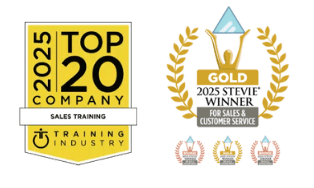Some of you are already being questioned about it. Soon, you will have to defend yourself. The great reckoning is on our doorstep. How good are you at this competency? To find out how well you are doing, just look at your sales team and you will know. Are they maximizing the use of technology to increase sales?
And, if you think the use of technology has accelerated, just wait until you see what is coming: Technology Tsunami! He who can maximize this, will win. Go check out what our Revenue Storm coach, Lon Cunninghis, posted here on LinkedIn from Gartner. HEADS UP… you may get a little excited about it.
The Current State of Salespeople Adopting Technology
Google the phrase “sales technology adoption,” and you will find low adoption rates side-by-side with high technology spend. I have heard as low as 14% adoption of CRMs! This is bad business. This situation is not uncommon, so you are likely familiar with these adoption responses from salespeople when asked why they are not using the technology provided to them:
(dismissive) “I don’t need that, and it takes too much time.”
(exasperated) “Let’s focus on more important sales issues!”
(annoyed) “I can’t access it.”
(surprised) “I didn’t know it did that.”
(skeptical) “I thought that was for marketing…”
(bewildered) “Which system?”
( silence )
As each day passes, we see top performing salespeople gaining an advantage using technology. According to Aberdeen Group, effective sales organizations are 81% more likely to consistently use a CRM or system of record. So, if your sales athlete has better equipment, why is it still sitting in the locker room? Lack of technology adoption creates a disadvantaged sales force. So how do sales managers drive the productive, and (dare we say) rewarding, adoption of technology? Can you hear yourself saying to them, “you will thank me later”?
Measuring Your Success at Leading Sales Technology Adoption
Success with this competency makes you distinctly more successful and more marketable as a sales leader. What would you say if you were asked today to report on your success at leading your fast-moving, quite stubborn, independently minded sales force to adopt technology?
When measuring adoption to see if you are succeeding at this competency, it is NOT reporting on the “number of logins.” Measure instead how often they use the technology to actually execute a sales activity, whether it is gaining customer insights, tailoring messages, improving leads, managing relationships, forecasting accurately, managing follow-up sequences, etc. So, how well has your team adopted the sales technology given to them thus far?
What Is a Change Leader Like
Change is hard. It is hard until it becomes a new habit. Then it is easy. Discipline is the hard work of overcoming current habits, and those have a tight grip. That is where you come in as a leader.
We all need a wise, encouraging, attention-getting, accountability partner to help us change habits, even if the habit is drinking less coffee every day. This is your goal as a leader of adoption. Your goal is to be that accountability partner, NOT the micro-manager.
The Steps to Leading Your Salespeople to Adopt the Sales Technology
Technology has arrived whether they had a say in it or not. So now what? How do you lead that adoption?
1. Demonstrate the Promise
- Be specific about the unique win for each person when using the technology. Do not be generic. They do not care about the generic benefits of the technology to a generic person.
- Yes, you are making a sales call! Do not leave it to an email containing their password. That is woefully inadequate selling.
- So, when you demonstrate this, create a conversation. Make the technology attractive, then listen to them. You will get insights revealing their hesitancy, excitement, preconceptions, etc. These insights tell you where to focus your attention next.
2. Remove the Ability to “Hide”
- We hang onto our habits because they are easy. Remove the temptation to continue the “old way” or it will stay and haunt you. Remove access to the old way. Give a firm cutoff date. This communicates pace and commitment.
- James Clear, author of Atomic Habits shared this wisdom: “Environment is the invisible hand that shapes human behavior.” Change the environment or it will beat you.
3. Define What “Adopted” Looks Like in Easy Increments
- Start with the easy things to adopt (not every single feature at once!) and let them experience the payoff. This will generate traction. Then increase the expectation. This will create momentum. You will eventually reach a tipping point of adoption.
- Be crazy specific in defining what “adopted” looks like in stages. Clarify the easy increments along the way. Celebrate these incremental milestones of adoption.
- Publicly track usage, outcomes, and share it with the team. Gather the good and the bad! We learn from both.
4. Train, Not Just Point and Click
- Motivation and inspiration must be a part of training design. Own this responsibility.
- Use their real work, not exercises in the training. They will have to return to the technology to continue their real work after training so now technology use is already “on the job.”
- Provide a 24×7 place for questions, live or not. Because it is in that exact moment when the question arises that people feel frustrated and abandon the technology.
5. Motivate From Every Side
- Use “carrot and stick” to help them win the battle of discipline. Incentivize adoption in a variety of ways to keep the buzz going. What about a fun incentive?
- Put it in your schedule. A rollout is “one and done” but adoption takes daily attention from you. In all leadership conversations, routines, processes, meetings, support for approvals, etc. mention the technology. This begins to demonstrate “this is how we now do business.”
6. Use Internal Influencers to Influence
- Find (or recruit) your influencers and grow that community, giving everyone a platform for their success stories, struggles, the “I did not know” excitement, and insider tips. Some people call this a communication plan for creating a growing user group.
- And by the way, fun fact, Influencers get paid to influence. It takes time, strategy, and attention. Incentivize your chosen influencers to actively do this work!
- Remember, FOMO (fear of missing out) is a powerful motivator. This is one way to create that.
Conclusion
Technology is aggressively coming into your sales organization. Succeed as a sales leader by creating your own technology adoption practice, then brag about it. You become a more marketable leader for the modern sales force. And, your salespeople will be thanking you later.
Personal Challenge:
Decide today what you are going to track to be able to brag about the adoption of technology under your sales leadership. Begin tracking two things: 1. Using the technology to execute a sales activity, and 2. The change in sales outcomes from that use. One highlight about sales outcomes: remember, “garbage in/garbage out.” That is part of what an organization needs to get good at to make your technology “dance” in powerful ways.




